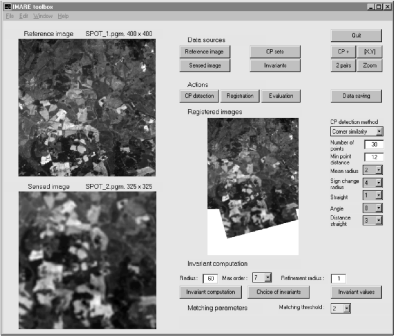

 System is available on request, please, send me e-mail to zitova@utia.cas.cz and I will send you back MATLAB code.
System is available on request, please, send me e-mail to zitova@utia.cas.cz and I will send you back MATLAB code.
System overview
IMARE toolbox, created in MATLAB
5.2.1, provides functions for the feature-based image registration. The
base algorithm implements the registration method, developed in our laboratory.
The toolbox offers easy selection of images for registration as well as
of parameters of registration subroutines. The toolbox supports evaluation
and visualization of achieved results and their saving for future processing.

IMARE toolbox: Flowchart.
IMARE toolbox highlights include:
System requirements
The system does not have any special requirements. The toolbox requires MATLAB 5.2.1 and Image Processing Toolbox 2.1. It can be run on WIN and UNIX platforms, where MATLAB 5.2.1. is runable.
Data input and output
Images
The following image formats for
importing the images, which are to be registered (reference and sensed
images) and for saving the registered images are supported: PGM (Portable
Gray Map), BMP (Windows Bitmap), JPEG (Joint Photographic Experts Group
Standard), PCX (Windows Paintbrush internal format) and TIFF (Tagged Image
Format).
Detected CPCs
CPCs detected earlier in the toolbox
or the ones stored in a database or generated by other feature detectors
can
be imported to the current session
of IMARE toolbox. CPCs detected during the session can be saved.
Two data formats for storing the detected CPCs are supported: coordinates
of detected CPCs as a plain text (*.txt files) or binary matrices,
where ones correspond to the CPC positions, saved as PGM images (*.pgm
files).
Computed invariants
Invariant descriptor values
computed earlier can be imported and the currently computed ones exported.
The
information about parameters used
for computing the descriptor values is stored in file headers.
Registration results
The registered sensed image and
computed estimates of the mapping function parameters can be stored. The
main image formats mentioned above are supported.
Data processing
CPC detection
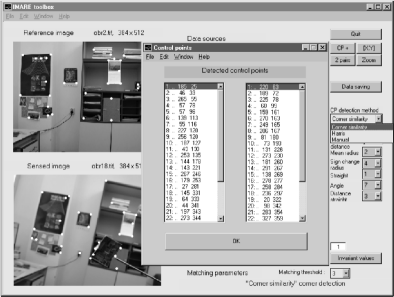
IMARE toolbox: Choice of the method
for CPC detection.
Detected CPCs can be marked in
the Reference and Sensed
images or their coordinates can
be listed.
The CPCs can be loaded from a database
or computed. Three different methods for the CPC detection are
implemented in IMARE toolbox. The
CPC detection section of the toolbox is extensible -- other detectors
can be implemeneted and easily
added.
In the activated MOD mode, the user
has a choice of one of the following three methods for the CPC detection:
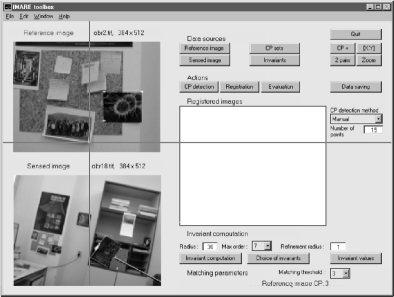
IMARE toolbox: Manual CPC detection.
The images can
be zoomed to achieve higher accuracy
of the detection.
In the activated AUTO mode, the
cornerness detector is used for the CPC detection. The parameters are set
to
default values.
Invariant computation
The values of invariants can be
either loaded from external files or computed. If MOD mode is activated,
parameters of the method for the
computation of the invariants can be changed by the user (the size of the
feature neighborhood for computation of invariants, the maximum order of
computed invariants, the threshold for the refinement of feature
correspondence). An option to select a subset of computed invariants for
the image registration is provided.
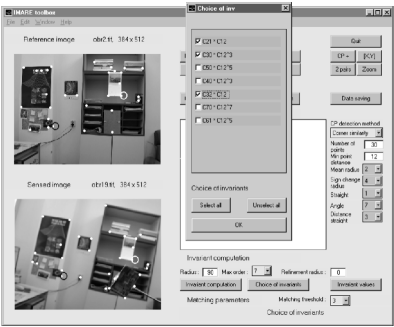
IMARE toolbox: Selection of the
invariant descriptors.
After the first stage of the CP
matching, the estimated
two most-likely corresponding CP
pairs can
be visualized (points inside black
and white circles).
Image registration
From the invariant description of
the detected features, the parameters of the mapping function are computed
by
means of the Match registration
method. The implemented similarity transform models the mapping function.
The
transform coefficients are computed
by means of the least square method. The registered sensed image,
transformed by the estimated mapping function, is generated. The type of
an interpolation method to be used (nearest neighbor, bilinear, bicubic
or spline interpolation) for the image resampling can be specified. In
MOD mode, parameters of the registration method can be changed.
Visualization and evaluation
Detected features
The detected CPCs are marked in
the Reference and Sensed Image windows. They can be individually visualized
in separate windows or their coordinates can be listed.
Image registration
IMARE toolbox offers various possibilities
of evaluating the results of the accomplished registration. The RMSE
(root mean square error) method for the evaluation of the registration
accuracy is provided. Point pairs required by the RMSE method can be imported
from a file, selected manually or chosen from the set of available matched
CPs.
These points are then omitted during
the computation of the mapping function parameters. For visual evaluation,
several visualization subroutines have been implemented to show the achieved
accuracy of the registration. The possible graphical output is:
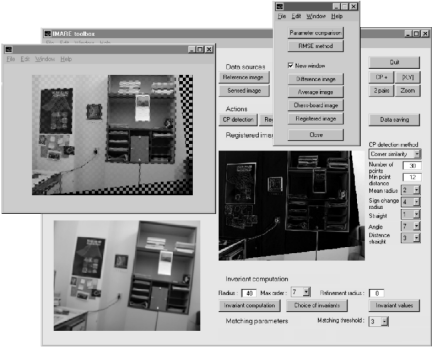
IMARE toolbox: Evaluation of achieved
accuracy of the registration.
The difference and the chess-board
images are shown.
Optionally, two best corresponding pairs of CPs from the sensed and the reference images, which are to be used for the first rough estimation of the mapping function parameters, can be highlighted. The listing and the display of CP pairs, which were established as corresponding and were used for the computation of parameters during the second parameter estimation, are also supported.
IMARE toolbox proved its applicability
as an image registration tool during the experiments, which have been carried
out. It is easily extensible; new
types of features, feature descriptors and matching algorithms can be added.
The graphical user interface facilitates the setting of method parameters
and allows the user to study the influence of the values of
the parameters on the accuracy of the registration results. The visualization
subroutines help to evaluate the achieved results.